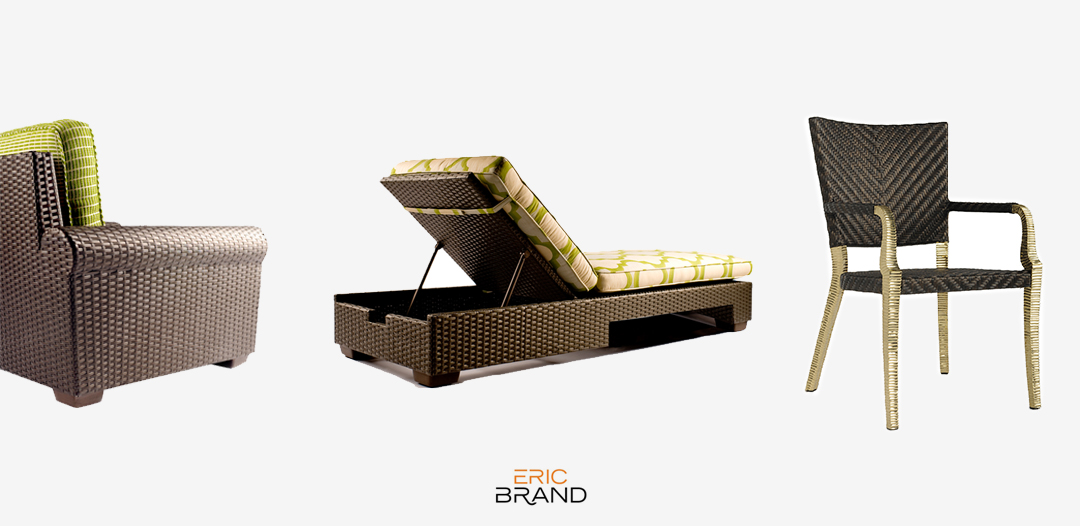As summer heats up, it’s only natural to want to spend more time outside with a cold drink, a hot BBQ, and watch fireflies dance around the evening sprinkler. To better enjoy these seasonal delights, the Eric Brand and Juniper outdoor series have been adorned with PVC and PE for optimal protection and comfort.
From our chairs and sofas to our end tables and coffee tables, PVC (Otherwise known as “Poly Vinyl Chloride” or just “vinyl” to the cool kids) and PE (Polyethylene) wraps and weaves are put to good use. Think of them as the stylish – and protective – icing on the cake. So what attributes make these materials so advantageous for outdoor furniture?
On the surface, the most notable difference between the two materials is that PE has a bit more of a matte finish and a dry hand. PE fibers are designed to look like natural rattan, and since it’s basically a “solution dyed” material, PE’s color is solid throughout – if scratched, it will be the same color underneath and will generally not show. As a result, it’s fade-resistant and doesn’t require paint or sealants for longevity. So should you or a guest accidentally scratch the Eric Brand Burlingame Lounge Chairs during your next gathering, an untrained eye would never notice it.
Conversely, PVC has a softer hand and a bit more of a shine than PE. PVC products are extruded in solid colors since they are machine produced, and utilizing this untouched PVC produces an item with no color variances. Once extruded, it can then be texturized and painted on the surface to create different looks – like our gray/brown leather looking weave on the Juniper J41 and J46 Chairs.
For the Juniper Outdoor collection we choose an extruded and embossed gray PVC with a hand applied gray/brown wash color to provide more depth and interest to the material. The craftsmen apply the finish at least 3 times and this creates natural color variances, which are part of the desired look of hand-finished PVC products. In fact, these slight variances in color are what make PVC very popular for raw material synthetics that resemble natural products.
Despite their unique qualities, PVC and PE share several attributes that make them both choice materials to work with. For starters, they are water and UV-resistant, so they can be left outdoors rain or shine, although everyone likes a little cover in the winter. They both wrap around lightweight powder-coated aluminum frames which are rust-resistant, durable and low maintenance because of the electrostatic process that applies the powder coating. For example, the Eric Brand Rue de Ray outdoor chair will sit pretty on your veranda for many summers because of its PE / powder-coated composition.
Furthermore, when it comes to being pliable, PVC rigid pipe can be shaped or cured with applied heat. It can even be nodded like rattan or bamboo, for a more organic aesthetic. Speaking of heat, PVC is a flame-retardant material, so while it will melt at very high temperatures, it won’t continue to burn once the flame source is removed. While PE is not naturally flame-retardant, in some cases it can be chemically treated to reduce its flammability, should a campfire or BBQ get out of control. After all, the only thing that should melt during summer are ice cubes and marshmallows.
Environmentally speaking, while both PVC and PE can be recycled at special waste facilities, PVC endures the recycling process a bit better by maintaining its pliability and retaining a lighter grey coloration. This allows PVC to be re-finished to a more natural-looking state, as it can have applied finishes be removed and changed. While PE’s uses (primarily because of its dark coloration after recycling) are a bit more limited, it is possible to recycle as well.
PE and PVC are both an excellent choice for designers and homeowners alike. Whether you prefer one over the other is simply a matter of personal taste based on the desired hand feel, color, shine, texture and overall design. Thankfully, they are equally easy to clean and maintain. This was just some of the thought put into the design and creation of the Eric Brand and Juniper outdoor collections. Check out these versatile-yet-sophisticated outdoor collections and redefine your summer experience while the days are still long…
––––––––––––––––––––––––––––––––––––––––––––
ERIC BRAND
Founded in 1996 and based in San Francisco, Eric Brand offers international custom-styled furniture and worldwide sourcing along with exquisite materials and finishes, specifically for the high-end residential design professional market and hospitality industry.
JUNIPER
Named after the fog-licked Juniper trees on the hills of San Francisco, Juniper is an in-stock furniture collection by Eric Brand reminiscent of the Art Deco movement in Paris that pays homage to timeless materials, techniques and silhouettes – brought to life through expert craftsmanship.

